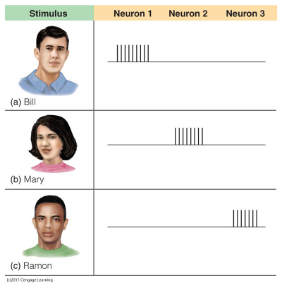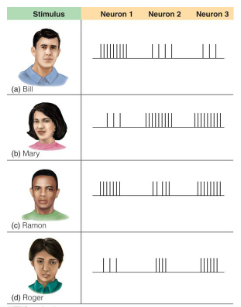Chapter 2 (PART 1) - The Neural Basis for Cognition - Neurons - PSYC340
1/38
Earn XP
Description and Tags
Chapter 2 for PSYC340 exam 1 split into two parts, this part is all about neurons
Name | Mastery | Learn | Test | Matching | Spaced |
|---|
No study sessions yet.
39 Terms
Complexity
The brain and nervous system are very complex
Integration
The brain integrates information from all senses. Nerves connect with at least 10,000 other nerve cells
Adaptability
The brain has to adapt to changing environment (ex. the brain uses different parts when walking to class vs being in class)
Neuroplasticity
Brain’s capacity for physical changes in response to experience
The brain’s ability to change, especially during childhood, by reorganizing after damage or by building new pathways based on experience
Developing new connections with new experience
Who first demonstrated Neuroplasticity, and what did she use to do so?
Dr. Mariam Diamond and colleagues at UC Berkeley
Caged rats in a stimulating (fun) vs unstimulating (nothing to do) environments
Brain matter of the rats in the stimulating environments was thicker (it developed more)
What are the two types of brain cells?
Glial Cells
Neurons
Glial cells
Cells that support, nourish and protect neurons
Physically and chemical buffering neurons
Removes dead neurons
Gives oxygen to neurons
Neurons
Cells specialized to receive and transmit information in the nervous system (Nerve cells)
What are the basic parts of a neuron?
Dendrites
Cell body (soma)
Axon
Myelin Sheath
Node of ranvier
Axon terminals
Dendrites (parts of a neuron)
Branch like protrusions at the top of the neuron which detect incoming signals.
Cell body/soma (parts of a neuron)
Contains the nucleus and cellular machinery
Axon (parts of a neuron)
Thin fiber that connects neurons so they can communicate. Transmits signals to other neurons via action potential
Myelin Sheath (parts of a neuron)
Covers the axons, insulates them and facilitates neural communication
Nodes of ranvier (parts of a neuron)
Refer to the gaps in the myelin sheath
Axon terminals (parts of a neuron)
Connect to other neurons
What are the three types of neurons?
Sensory (afferent) neurons
Motor (efferent) Neurons
Interneurons
Sensory (afferent) Neurons (types of neurons)
Transmit information from environment to central nervous system (CNS)
Any physical sensation
Takes information from the environment and body and sends it to our brain
Motor (efferent) Neurons (types of neurons)
Transmits information from the central nervous system (CNS) to muscles/organs/glands
Interneurons (types of neurons)
Connect the brain regions
ex. can enable connection between afferent and efferent neurons
Enables us to do higher order cognitive functions
Action potential (communication within neurons)
Electrical signals that enable communications within neurons
If the stimulus reaches threshold, an action potential is fired and propagates (moves) down the axon
The process of action potential
In response to a signal, the soma end of the axon becomes depolarized
The depolarization spreads down the axon. Meanwhile, the first part of the membrane repolarizes. Because the Na channels are inactivated and additional K channels have opened, the membrane cannot depolarize again.
The action potential continues to travel down the axon.
Depolarizing (Process of action potential)
Small gates in the cell wall open, allows fluid containing positive charged ions flows in and stops change differential.
Repolarizing (process of action potential)
Changing back from positive ions to negative ions.
All-or-none law
The strength in which a neurons fires is independent to the strength of the stimulus. If the stimulus exceeds the threshold level, then the neuron fires (all). If it doesn’t reach the threshold, it doesn’t (none).
Either the stimulus fires or it doesn’t
If the signal is sent, it is always the same magnitude (neurons only have one strength they can send)
How to measure action potential
The size is not measured; size remains consistent
The rate of firing is what’s measured (how intense the stimulus is)
Low intensities: slow firing
High intensities: fast firing
Neurotransmitters (communication between neurons)
Chemical released by one neuron to communicate with another neuron
Synapse (communication between neurons)
The region where axons of one neuron and dendrites of another come together.
Presynaptic neurons (communication between neurons)
Neuron that releases the neurotransmitters
Postsynaptic neuron (communication between neurons)
Neuron that receives the neurotransmitters
Reuptake (communication between neurons)
Reabsorption of a neurotransmitter by the presynaptic neuron
Excitatory effects (neurotransmitters)
Encourages the next neuron to fire (ex. serotonin)
Inhibitory effects (neurotransmitters)
Keeps the next neuron from firing (ex. GABA)
GABA (Inhibitory effects)
The brains break petal
Keeps neurons from firing to neurons we don’t want it to go to
Neural representations
How our brain represents different objects, experiences, memories, cognitive functions
Feature detectors (Neural representations)
Neurons that fire only to specific qualities of stimuli
Orientation, movement, length
Found in early stages of visual processing
Sensitive to lines and combinations of lines
Sensory coding (Neural representations)
How neurons represent characteristics of the environment
Specificity coding (sensory coding)
Representation via single dedicated neurons
ex. a neuron for your pet, neuron for your mom

Sparse coding (sensory coding)
Representation via a pattern of firing across a small number of neurons
ex. the area around you when walking to class
Distributed coding (sensory coding)
Many neurons working together to encode information
